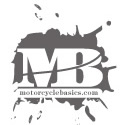Motorcycle Riding Gear
There is no arguing the fact that riding a motorcycle can be a dangerous activity. Compared with other vehicles that are equipped with safety features such as airbags, seatbelts and steel cages; motorcycles are quite bare. This leaves riders (and passengers) somewhat vulnerable. It amazes me the number of riders that I see on the road with little or no protective gear to speak of! Either they don’t realize the danger or they just don’t care, whatever the reason there is very little thought behind it. If something were to happen, a T-shirt, shorts and flip-flops will provide very little protection! The best way a rider can protect themselves would be with the proper protective riding gear. What does the proper riding gear consist of?
Motorcycle Helmets
There are a wide variety of types of helmets on the market, ¼, ½, ¾ and full face. In order for a helmet to be legal on the street it must meet certain government safety standards, some of the most common standards that you will find are the Department of Transportation (D.O.T.FMVSS 218 ), the Economic Community of Europe(E.C.E. 22-50) or the British Standards Institution(B.S.I. 6658).Along with these government standards there is also the Snell M2010 standard, a voluntary private standard used primarily in the U.S. and Canada for racing. Every motorcycle helmet used on the street in North America must at least have a DOT, B.S.I. or E.C.E rating. The Snell rating is only required for motorcycle racing and is updated at 5 year intervals.
Over the last few years there have been many debates over which standard is the best. Which standard should you choose? This is a hard question to answer. I recommend that you get as much information on each standard as you can and then draw your own conclusions as to which is suitable for you.

Although this option may protect the head from the sun’s rays and the wind, it does nothing to protect the head from injuries due to impact with hard objects (curbs, poles, cars etc.).

This style of helmet is known as a 1/4 helmet, “beanie” or "skull cap". These helmets at best meet the bare minimum to be legal on the street and offer very little protection if any at all! In some cases these helmets may not even meet any safety standards.

This style of helmet is known as a ½ helmet .It is acceptable but it only protects the top of the head. So a rider would have to land on the top of his/her head to get the best protection. There is no protection for the eyes and face from debris, bugs or rain. These helmets are normally D.O.T. approved.

This style of helmet is known as a ¾ helmet. It does better job of protecting the top, back and sides of the head. This helmet may also have a visor that will protect a rider’s face from flying debris such as dirt, rocks and bugs. There is however very little protection if the rider were to fall face first, he/ she could receive injuries to the jaw, mouth or teeth.

A full-face helmet is considered to be the best because it protects the rider’s entire head. If a rider were to fall forward the chin bar would protect his/ her jaw and mouth, plus the face shield keeps debris, rain and bugs out. If you have ever had a bug, pebble or rain drop hit you in the face at highway speeds then you will appreciate having a shield.


This modular helmet offers the best of both worlds. Modular helmets offer the protection of a full-face helmet with the added convenience of a chin bar/ face shield that can be raised so the wearer can have a conversation, drink or a quick bite to eat, without having to remove their helmet. This style of helmet is becoming very popular especially with the touring/sport touring crowd.
In order for a helmet to do its job correctly it has to fit properly. A helmet should fit the wearer snug but not tight. While the helmet is on, hold the helmet with both hands and turn your head. If your head can move side to side in the helmet then it is too loose. When trying on a helmet in a store it is a good idea to keep it on your head for about 15 minutes or so, this way you will discover any pressure points that could cause discomfort. It should also be noted that most stores have a non-return policy on helmets.
How long does a helmet last?How long a helmet will last depends on a number of factors. First it should be stated that a motorcycle helmet is good for one major impact only! If a helmet were to come into contact with concrete, asphalt or any other hard object/ surface it may be damaged. Can you tell if it has been compromised by looking at it? No! In the event you drop your helmet or it has been involved in an accident, it is a good idea to replace it! I often see riders leaving their helmets in their bike (seat, mirror, tank, etc.) where a gust of wind or passerby could easily knock it off, a drop from that height could potentially damage the helmet.
Believe it or not helmets have a lifespan. Most helmet companies recommend you replace your helmet after approximately 5 years of regular use. My helmets tend to starts to feel a little loose (the foam has compressed a bit) after the 5 year mark and the mechanisms (vent buttons, face shield pivot, etc.) don’t work as well as when the helmet was new. The more you wear a helmet (I wear mine almost every day for the 8 month season in Ontario) the quicker it will wear out, whereas if you only wear your helmet a few times a month then it probably will last longer.
Should you buy a used helmet?I have heard of a few people buying used helmets from their friends or receiving a used helmet with a motorcycle in a private sale; personally I would not buy a used helmet period! There are a couple of reasons; firstly it is almost impossible to be sure of its condition (has it been dropped?), and secondly do I want to wear a helmet that someone else has perspired in it? Not particularly!
What do helmets cost?Since helmets come in a variety of styles, you can expect a range in price, approximately $150 to over $1200+ Canadian. What should you pay for a helmet? That is a personal choice. It is always interesting to see the look on people’s faces when I tell them that I have paid close to over $500 for my helmet. Most seem to think that I’m insane but when it comes to protecting my head and brains, I’m not willing to take chances. If there is one piece of equipment that I will not skimp on it is a helmet. When people ask me if it is okay to buy a $25 to $50 helmet my response is “If you have a $25 to $50 head, then buy a $50 helmet, I prefer to think that my head/ brains are priceless!” Personally the cheapest I would pay for a helmet (regular price) is in the $150 - $200 range.
Does a more expensive helmet protect better than one that is less expensive?The answer to this question is not exactly clear cut; for the most part a $200 helmet will offer about the same protection as one costing $1000, providing they have the same safety rating. Then why pay more money for a helmet? The answer is “Comfort, style and convenience”. As you go up the price range, helmets will be made of lighter materials, have more features (quick release face shields, removable washable liners, more ventilation etc.). If a helmet is comfortable then you are likely to wear it for longer periods of time. I find that if my helmet is comfortable my concentration is better (I almost forget I’m wearing it) and I can ride longer. Plus a helmet with a great paint job is cool!!
Comparing a $200helmet to a $1000+ helmet is like comparing a Geo Metro to a Porsche 911 Turbo, they both perform the same basic function (going from point A to point B); the Porsche just does it with more style!
The next important item of gear to consider is a jacket. In this day age there are a wide variety of styles as well as material to choose from.
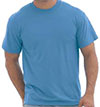
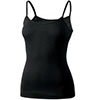
Although a T-shirt or a tank top may seem like a good idea on very hot day, they will offer no protection in the event the rider is unexpectedly separated from his/ her motorcycle (fall). It may look cool but in actuality a rider wearing a T-shirt runs the risk of becoming dehydrated or sunburned, not to mention the possibility of road-rash. Save the T-shirt/ tank top for the car or the beach!
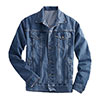
A denim jacket is a step up from a T-shirt, but just barely! At slower speeds (stop and go traffic) this type of jacket will give the rider a minimum amount of protection from abrasion. As the speeds increase (highway speeds) however, that protection is reduced significantly. The denim jacket will be torn to shreds if the rider were to fall at highway speeds!
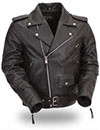
The classic “leather biker jacket” is definitely a step up from a denim jacket and a huge step up from a T-shirt! The leather used for this type of jacket is strong enough to provide protection against abrasions (road-rash). A drawback of this style is that it offers no impact protection (padding/ body armor in the elbows, shoulders or back). On hot days a black leather jacket without any vents or perforations can get very hot indeed.
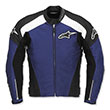
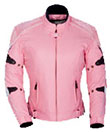
When it comes to protection a modern leather motorcycle jacket is tough to beat. They are made of thick leather (cow, kangaroo etc.) that provides abrasion protection, as with the classic biker jacket. The similarities end there however, modern jackets have had decades of testing (Research & Development) from racing and street riding. Along with the abrasion protection, most jackets come with armor (soft or hard padding) in areas (elbows, shoulders, back and kidneys) that could come into contact with the road or other solid objects. The sleeves are also curved for comfort since a rider’s arms are slightly bent while riding.
For warmer weather most jackets will have perforations / vents in key areas that allow air to flow through keeping things cool. In addition most jackets also come with removable liners for when the temperature gets cooler. They also have tapered sleeves and collars that close snugly to keep draft and bugs from getting in. Reflective material may also be added for extra visibility when it gets dark. Most jackets also have zippers (in the back) that allow a pair of riding pants (Leather or Ballistic Nylon) to be attached
Alternative to leather
Ballistic nylon:In the past if you wanted a sturdy motorcycle jacket there was only one option available; leather. Now however, with the advancements in technology we have man-made fabrics such as ballistic nylon (also referred to as textile). This fabric is a weave of nylon and other fabrics such as “Kevlar” to give the material extra strength against abrasion. This type of jacket has become extremely popular for a number of reasons:
- Weight - a ballistic nylon weighs less than a comparable leather jacket.
- Cooler/ warmer than a leather jacket (lighter material and better wind protection)
- Some ballistic nylon jackets are waterproof or have removable liners that are waterproof.
- Price – Ballistic nylon jackets usually cost less than leather jackets.
- Most jackets also have zippers in the back that allow a pair of pants (Leather or ballistic nylon) to be attached
It should be noted however ballistic nylon jackets are good for one major fall only. While most textile jackets may have the same type of armor as leather jackets the material itself is not as abrasion resistant as leather and will usually tear during a significant fall. That being said, a good quality ballistic nylon jacket will provide exceptional protection for everyday street riding. For the race track however leather is still the only choice!
- Denim jacket: $50 - $100+
- Classic motorcycle leather jacket: $100 - $300
- Ballistic nylon motorcycle jacket: $150 - $500+
- Modern motorcycle leather jacket: $250- $800+
As human beings we depend on our hands daily for most of the things we do. Without our hands the most mundane tasks would be much more difficult, so protecting them with a pair of gloves (when riding a motorcycle) is definitely a good idea.

You are walking and you trip (and begin to fall), what is the first thing that you do? Instinctively your hands come forward to try and save yourself from falling. The same thing will happen if you fall while riding a motorcycle. The only difference is on a motorcycle you will more than likely be traveling faster than a walking pace. Riding with bare hands may give you a better feel for the controls and feel good on a hot day, but if something were to happen your hands could get injured.

This type of glove does give some protection to the palms, but the fingers and parts of the back of the hands are unprotected. Overall these gloves will not provide very good protection in a fall, because the wearer’s fingers are totally exposed. This type of glove my look cool but they will not be so cool in the event of a fall of any kind.

Though this type of glove will cover the entire hand they are made of cotton and will tear very easily which will not protect your hands.

As with the previous gloves mechanics gloves also cover the entire hand. The leather used on the palms is very soft and will not offer very good abrasion protection. Furthermore the material on the back is usually made of mesh which will tear easily. I would recommend wearing these gloves to work on your bike. They are great for handling tools, but offer poor protection from abrasions.

This type of glove is adequate for riding because they are constructed of thick leather (palm) and a sturdy cut and abrasion resistant material (back). The gauntlet style is also good for keeping cold air and bugs out when riding. The drawbacks that some riders experience with this type of glove are that they don’t breathe very well and they tend to be somewhat bulky and can make operating the controls a little difficult or cumbersome.
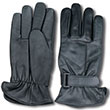
This is the basic leather motorcycle glove. These gloves will give good abrasion protection for a rider’s entire hand. The palms usually have two layers of leather for extra abrasion protection, as well as a gauntlet and straps to keep them in place and cold and bugs out. You can also get gloves that are perforated which will keep your hands cool on hot days.

When it comes to protecting your hands, this type of glove is hard to beat. Some of the features that you would find in this style of glove are:
- Two layers and extra padded palms
- Double stitching for extra strength
- Knuckle protection (carbon fiber or other materials)
- Gauntlets to protect the wrists and fit over jacket sleeves
- Venting to keep hands cool
- Curved fingers for comfort and grip
Cost: Generally you can find a fairly decent pair of motorcycle riding gloves for around $35 and the price can climb as high as $300+ for a top quality racing glove.
Wearing a pair of pants while riding is unquestionably a good idea.
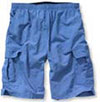
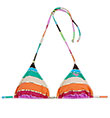
As summer rolls on and the mercury starts to rise close to or above 25˚C (77˚F), some riders are willing to wear shorts or swimsuits while riding. How much protection will these clothing provide? None!!! Like the T-shirt/ tank top, they may look cool at the beach or by a pool, but not riding a motorcycle.

For general everyday riding a good pair of sturdy denim jeans may be acceptable, they provide more protection than a pair of shorts.

A step beyond your basic pair of jeans is a pair of motorcycle jeans. What sets these apart from a regular pair of jeans is they are reinforced in critical areas (knees, hips and seat) with Kevlar or similar materials which are considerably more abrasion resistant than denim.
Chaps: Leather Chaps are very popular with cruiser riders as they provide some abrasion protection (except in the seat area), as well as warmth. In order to provide good protection chaps should be worn over a sturdy pair of jeans.


Motorcycle leather pants provide excellent abrasion protection and have extra padding in the knee and hip areas.
When it comes to ultimate protection leather motorcycle racing pants can’t be beat! Constructed of thick leather (cow, kangaroo, etc) they will protect against abrasions. There is also armor/ padding in key areas (knees, shins, hips and seat) for added impact protection. Other features may include elastic material in the knee and pelvic areas for ease of movement and comfort, as well as vents/ perforations to keep you cool and a zipper to attach the pants to a jacket.

As with motorcycle jackets, there are many companies that offer pants made of ballistic nylon. This type of pant offers very good abrasion protection as well as padding in key areas (knees/ shins, hips, and seat). Some of the other features you may find in ballistic nylon pants are vents, waterproofing and zippers to attach the pants to a jacket.
Cost: You can expect to pay approximately:
- $100 - $200 for motorcycle jeans
- $100 - $250 for leather chaps
- $150 - $400+ for ballistic nylon pants
- $150 - 300+ for leather motorcycle pants
- $250 - 500+ for leather motorcycle racing pants
Most companies also offer one piece or two piece suits in leather or ballistic nylon.
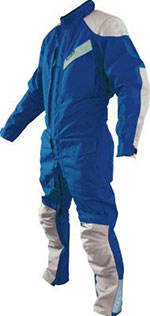
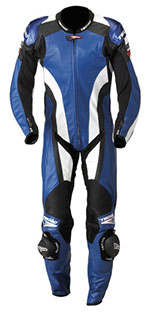
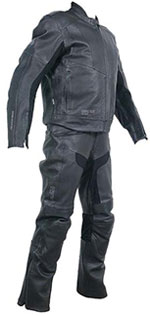
Wearing a one or two-piece riding suit will provide full body protection. The hard part is deciding whether you want a one or two piece suit. A one-piece will do a better job keeping the wind out and will not have any gaps around the waist. While a two-piece is more versatile as the top and bottom can be worn together or separately and may be easier to get in and out of. For the race track however, a one-piece leather suit is the best choice.
Price: You can expect to pay anywhere from $500 to $2000 for a one or two-piece suit.
It never fails to amaze me the inappropriate footwear that I see riders/ passengers wearing. Just like the rest of the body the feet need to be protected as well.
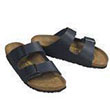
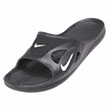
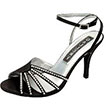
Sandals, slippers, flip-flops and dress shoes will not provide any protection in the event of an incident. In fact at the first sign of trouble they will fall off, leaving your feet open to injury (abrasions, broken toes, etc.)
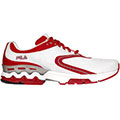
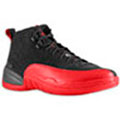
Running shoes are fantastic for running, walking or other activities, but are not the best choice for riding motorcycles. In terms of protection they will offer more than a sandal or flip-flop, but not that much more! The problem is that the material is not sturdy enough nor do they protect the ankle bone very well (not even high tops). In most incidents where the rider was wearing runners one or both end up coming off!
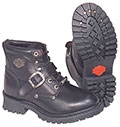

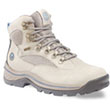
A sturdy pair of leather boots will provide good protection. This type of boot will protect the entire foot including the ankle bone. A lower rubber sole will provide better balance and traction.
A leather/ suede hiking boot will provide better protection than a high top running shoe because they are constructed out of sturdier material.

Motorcycle racing boots are the ultimate in foot protection! The rider’s feet (toes, heels, ankles and shins) are protected and are available with vents or perforations (also available in waterproof versions) to keep your feet cool on hot days. Motorcycle racing boots are excellent for riding, but because of their stiffness they are usually not very comfortable for walking long distances or standing for extended periods of time.
An alternative to a motorcycle racing boot is a motorcycle touring boot. This type of boot will provide great protection for a rider’s feet. Since they are not as rigid or stiff as a racing boot, they will be more comfortable for walking and standing. You can also find touring boots that are warm and water-proof, which will keep your feet warm and dry.
Cost: You can expect to pay roughly:
- $50 - $150+ for normal leather boots.
- $150 - $250+ for leather motorcycle touring boots.
- $150 - $500+ for leather motorcycle racing boots.
Along with riding gear that protects a rider in the event of a fall there is additional gear that will provide extra comfort while riding.

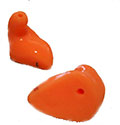
Motorcycles produce noise (engine and exhaust), as well as the wind rushing by while the bike is in motion. Prolonged exposure to this noise can cause permanent hearing loss. An excellent way for a rider or passenger to protect their hearing is by wearing earplugs. Earplugs will reduce the noise that can cause hearing loss, while still allowing the rider to hear crucial sounds such as sirens and horns. Earplugs will also eliminate white (wind) noise reducing fatigue especially on longer rides. There are basically two types of earplugs; disposable and custom made. Custom earplugs will be more comfortable (made for the wearer’s particular ear shape and size), but will cost considerably more! Disposable earplugs are easier to replace if they are lost, because of their much lower cost than a custom pair.
Cost:
- Less than a dollar for a pair of disposable earplugs.
- $80 - $100+ for custom fitted earplugs.
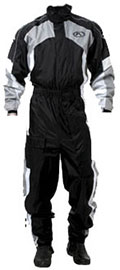
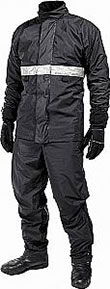
"Behind the clouds the sun is shining, thy fate is the common fate of all, into each life a little rain must fall, some days must be dark and dreary."
- Longfellow
Rain is something that every ride will encounter sooner or later if they ride long enough. Now I know there are riders who only go out when he weather is perfect (fair-weather-riders). In theory this may seem like a good idea, but think of how many days of riding are missed only riding when there is little or no chance of rain. What if it starts raining half way through a ride? Then what? Leather is not waterproof; it acts like a chamois (shammy) or sponge! Every rider should invest in a rain suit.
When purchasing a rain suit make sure that it is large enough to fit over your regular riding gear (jacket, pants etc.), it makes little or no sense to replace leather, ballistic nylon jacket or denim with thin piece of nylon. You will keep dry but you will not have any protection against abrasions (road-rash).
It is a good idea to get a suit that is specially made for riding a motorcycle. Although you can get cheaper basic rain suits they don’t fit as well while riding (riding up leaving ankles and wrists exposed) or last as long.
As far as rain suits go there are two styles; one-piece or two-piece.
A one-piece rain suit offers slightly better protection from rain as there are fewer places for water to enter. That being said a two piece suit is much easier to get on and off, especially on the side of the road.An alternative to buying a leather jacket, pants and a separate rain suit, is to get a waterproof ballistic nylon (textile) suit. Most waterproof textile suits will have a liner that can be removed when it is not needed.
Cost: You can expect to pay approximately:
- $20 - $50+ for a basic rain suit.
- $80 - $100+ for a motorcycle rain suit.
- $500 - $900+ for a waterproof ballistic nylon suit.



Good vision is a fundamental part of riding a motorcycle. A rider must be able to see what is going on around him or her. Having a bug, rock or other debris in an eye, especially at highway speeds is definitely not a good thing. Any rider who wears an open face helmet should wear some form of eye protection such as sun glasses (daytime only), safety glasses or goggles, to protect their eyes. Eyewear that wrap around the eyes is preferable as it will keep dust and debris from entering from the sides, while goggles protect from all directions
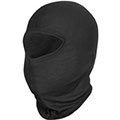

When the weather gets a little cool (early mornings, spring and fall etc.) a rider may find it difficult to keep the cold out.
A balaclava and neck warmer will keep the head, neck and upper chest area from getting chilly. Thermal underwear will keep the rest of the body warm and comfortable.
If you are riding in very cold weather you might consider using a heated vest and heated gloves.
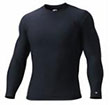

Keeping cool when the Mercury starts to rise can also be a problem. Riding without safety gear should never be an option. How do you keep cool? A lot of professional athletes; football players, baseball players and motorcycle racers have turned to dry-wicking material to help keep them cool and dry. This material worn under riding gear can help keep a rider comfortable on the warmer summer days.
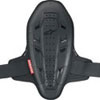
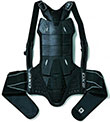
When riding a motorcycle it is hard to have too much protection, in my opinion! Although most modern motorcycle jackets have some form of back protection (typically a foam pad), more and more riders (especially sport-bike riders) are wearing back/ spine protectors for added protection against back and spinal cord injuries. Once I started wearing mine, I feel uncomfortable if I ride without it.
Cost: You can expect to pay around:
- $100- $200+ for back protector.
There are definitely risks associated with the sport of riding a motorcycle and although these risks cannot be totally eliminated they can certainly be minimized. Wearing motorcycle riding gear along with practice are two of the best ways that a rider can protect themselves. I see a lot of riders wearing next to nothing flying down the road! What is worse, in most cases their passenger has less gear on; usually only an old scratched covered helmet that is two sizes too big. As a rider I would never consider riding without all my gear and no one gets on the back of my motorcycle without their gear as well! If something was to happen and we were unexpectedly separated from my bike a T-shirt and a pair of shorts won’t cut it. The passenger’s life is in the rider’s hands and the rider should do his or her best to protect them.
Now I know that some of you are saying to yourselves that this could get expensive! I am not suggesting that anyone go out and spend a small fortune on riding gear (especially before they decide if riding is for them), what I am suggesting is that a rider spend what they can afford. If you are new to riding, you might want to start off with a decent helmet, a sturdy leather jacket, a durable pair of leather gloves, jeans and a basic pair of sturdy leather boots. As time goes by you can replace the basic gear with gear that is better suited for riding a motorcycle. Price should not be the only deciding factor, others that should be more important are fit and comfort; the most expensive helmet or jacket will offer very little protection if it doesn’t fit properly or is uncomfortable to wear.
- Motorcycle shop/ dealership - Most local motorcycle shops will have a good selection and knowledgeable sales people to help with the proper sizing.
- Internet - There are literally 1000’s of places and people selling gear on the internet (Chaparral motorsports, EBay, kijiji etc.).The prices may be less but one must be aware of the risks of shopping on the web (items not showing up, fraud etc.). Another problem to be aware of is sizing; European, Japanese and American sizing can be very different. Before purchasing an item you may want to try on an item from that company (at a local bike shop) to determine the correct size.
- Bike Shows – This is probably where you will find the best selection as well as price. A large number of venders trying to sell as much as possible in a short period of time (normally a weekend). I find that the best time to get the best deals is the last day just before the show closes. Most venders want to pack up and bring back as little merchandise as possible. As a result they are more willing to drop their prices further.
When riding a motorcycle you never know when something might happen, so a rider must be prepared at all times! I have heard a lot of riders say “I’m not going far so I don’t need to wear my gear”. Where do most incidents happen? Statistically it has been shown that a large percentage of incidents happen approximately 10 minutes from the destination or from place of origin. Why? Most riders/ drivers go on autopilot when they are close to places that they go to frequently (home, work, shopping mall etc.)
Safety gear is like life insurance:
"We buy it hoping that we never have to use it, but it is there if we do!”Ride safe and always wear your safety gear!


